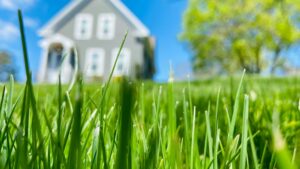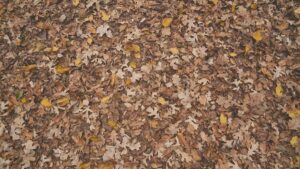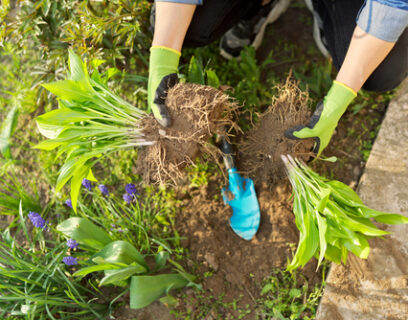Log in or create new account to save this product to your wishlist.
8 Tips for a Bird-Friendly Garden
Birds contribute to the biodiversity of our gardens, feeding on many of the grubs and insects that can damage our lawns. Find out how to create a more bird-friendly garden.
Latest blogposts
7 MIN 22 Jul How to keep your lawn in shape this summer 9 MIN 15 Jul Watering Your Garden: 10 Top Tips! 11 MIN 15 Jul Is Your Grass Type Right for your Garden? 4 MIN 03 Sep Gardening in September — jobs to do 7 MIN 23 Aug How to Encourage Bees in Your Garden 5 MIN 14 Aug Pruning Lavender: when, why and how?Do you love to listen to the cheerful chirping of happy birds in your garden? Perhaps you’re an amateur bird watcher, and you love to see a wide variety of our feathered friends fluttering around your seed feeder? You need a bird-friendly garden.
Birds contribute to healthy soil and are good for the biodiversity of your garden. They eat the grubs and insects that often damage our plants and our lawns, so encouraging more birds into your garden can help your greenery thrive.
Follow our 8 easy tips for a bird-friendly garden, and reap the rewards of a garden that’s rich in biodiversity.
Ready? Let’s go!
Plant a lawn

Birds are attracted to our lawns because insects live within the soil and serve as delicious, protein-rich fodder.
So, planting a lawn is one of the best ways to encourage more birds into your garden. We have LOTS of great advice for lawn lovers but, sometimes, you’ll run into problems.
If you see yellow or bald spots developing throughout your lawn, you may have leatherjackets or grubs. Birds LOVE these grubs. We often refer to “people who eat like a bird” as if they barely have any appetite; they haven’t seen birds eating their way through a population of lawn-damaging insects.
Also, blackbirds love to peck the worms out of your lawn. Win-win.
Vary the plants that bloom in different seasons
Your garden is a little self-sustaining ecosystem.
The flowers on our plants attract pollinators and insects, which help our plants yield fruit and multiply. These insects, in turn, attract the birds because they’re a great source of food.
And when our plants die off in winter, the birds eat their seeds.
On top of that, the dead organic matter left behind from perennial plants makes excellent nesting material.
Plant buckwheat, rape, or sunflowers for prime nesting material.
Plant trees and bushes
Birds love to live high up in the trees, so planting large trees and shrubs will create hospitable, safe, sheltered retreats for their nests.
Bushes that produce berries and fruit provide an excellent, plentiful food source. You might not want the birds getting at your raspberries, of course, so cover those over with mesh or a polytunnel to protect your crop.
Birds love blackcurrants, blackberries, redcurrants, and raspberries. Alternatively, you can choose bushes whose berries aren’t suitable for human consumption but are perfect for birds.
The following berry-bearing bushes are bird-attractors:
- Rowan
- Holly
- Whitebeam
- Dog rose
- Spindle
- Guelder rose
- Hawthorn
- Ivy
- Honeysuckle
- Elder
And these attractive shrubs are also bird favourites:
- Cotoneaster
- Pyracantha
- Berberis
Wait before you prune

Most bushes and shrubs benefit from an annual pruning, helping encourage new growth the following year. But if you prune at the wrong time, you cut off the food source for the birds you’re so keen to invite into your garden.
Prune before March or after July, which is the breeding season for most birds. And before you prune, check for the presence of nests.
If you find a nest, wait until the last bird has flown away for the winter before you start hacking.
Feed the birds
Many UK birds migrate to warmer climes once the summer is over. However, those that remain experience a severe lull in their food supply. So, feeding the birds throughout the winter is always welcomed.
Tradition has it that birds love bread, but – actually – bread doesn’t supply enough protein or fat for a healthy avian diet and is considered an “empty filler”.
Instead, fill your bird table and feeders with:
- Fat balls
- Peanut rings
- Special bird peanut butter
These treats provide the fat and protein birds need to get through the colder winter months.
And there’s no denying: a birdhouse in the garden offers hours of fascinating watching.
Build a pond
A garden pond doesn’t have to contain fish. A small, shallow pond provides birds with a place to drink and bathe and encourages a wealth of other wildlife (which birds also find irresistible).
But ponds aren’t just for birds; they attract foxes who drink from the pond and pipistrelle bats who feed on the insect life that grows there. And damselflies and dragonflies (if you’re lucky) lay their eggs on aquatic plants.
If you don’t have room for a pond in your garden, you could install a smaller water dish, which will have the same effect.
Leave the leaves behind

We always know when autumn has arrived because the trees start to shed their leaves. And it’s incredibly tempting to rake them up immediately but think about the wildlife that relies on this fallen organic matter.
Insects live among the fallen leaves, which attracts the birds.
Additionally, fallen leaves create a natural mulch layer for your flower beds, which, in turn, protects your plants from frost.
Do not use poison
Many of us rely on pellets to combat slugs and snails, but have you thought about the potential consequences for the birds that eat the slugs? Applying poisons (such as weed killer) to your soil is a genuine hazard for the wildlife that enjoys your outdoor space, so try and think of more humane or “green” ways to tackle weeds and pests.
For example, you can build slug traps by filling an old jam jar with beer and burying it amongst your veg. The slugs are attracted to the beer and fall into the trap and drown. And, while that’s still pretty grim, it’s probably better to drown in a vat of beer than to burn to death from chemicals.
You’re potentially destroying a valuable food source for your birds when you kill off the pests. If they find no food to sustain them, they’ll fly away somewhere else.
If you’re looking for another way of getting rid of weeds, check out our 15 tips to control and remove weeds.
Explore Our Help & Advice Page
We hope you’ve enjoyed reading our expert tips for creating a bird-friendly garden.
We have plenty more information and tips about achieving and maintaining the perfect lawn on our Help & Advice page.
And we’re always happy to help. Email us at hello@moowy.shop if you have any questions.
Good luck with creating your own bird-friendly garden!
Leave a comment
Your answer will be displayed on the site and the interested party will be notified by email.
Leave a comment
Have a question or want to share your experience? Leave us a comment.
Read more
The best tips and tricks for a lush green lawn
 4 MIN
03 Sep
Gardening in September — jobs to do
4 MIN
03 Sep
Gardening in September — jobs to do
 7 MIN
23 Aug
How to Encourage Bees in Your Garden
7 MIN
23 Aug
How to Encourage Bees in Your Garden
 5 MIN
09 Aug
4 Tips for more Ergonomic Gardening!
5 MIN
09 Aug
4 Tips for more Ergonomic Gardening!
 Scarifying Kit
All products after scarifying | Quickly restores the lawn after scarifying | Outsmart weeds quickly with the use of this kit
From: € 39.99
Scarifying Kit
All products after scarifying | Quickly restores the lawn after scarifying | Outsmart weeds quickly with the use of this kit
From: € 39.99
 Spring Lawn Care Kit
MOOWY’s choice for the spring | Quick recovery of your lawn after winter | A strong lawn prevents weeds
From: € 25.99
Spring Lawn Care Kit
MOOWY’s choice for the spring | Quick recovery of your lawn after winter | A strong lawn prevents weeds
From: € 25.99
 Long Lasting Lawn Fertiliser
Effective for 90 days | See results in 14 days! | Suitable for all types of grass and soil
From: € 13.99
Long Lasting Lawn Fertiliser
Effective for 90 days | See results in 14 days! | Suitable for all types of grass and soil
From: € 13.99
Do you want a lawn calendar?
🌱 All important maintenance moments for your lawn during the year. Leave your email and we will send you the lawn calendar for free.
Enter your email
Receive the lawn calendar in the mail
Enjoy a green lawn all year round!









Comments (0)
There are no comments yet. Well then, what are you waiting for to
Be the first to write your comment!inaugurate this pretty page?
Do you have some comments?